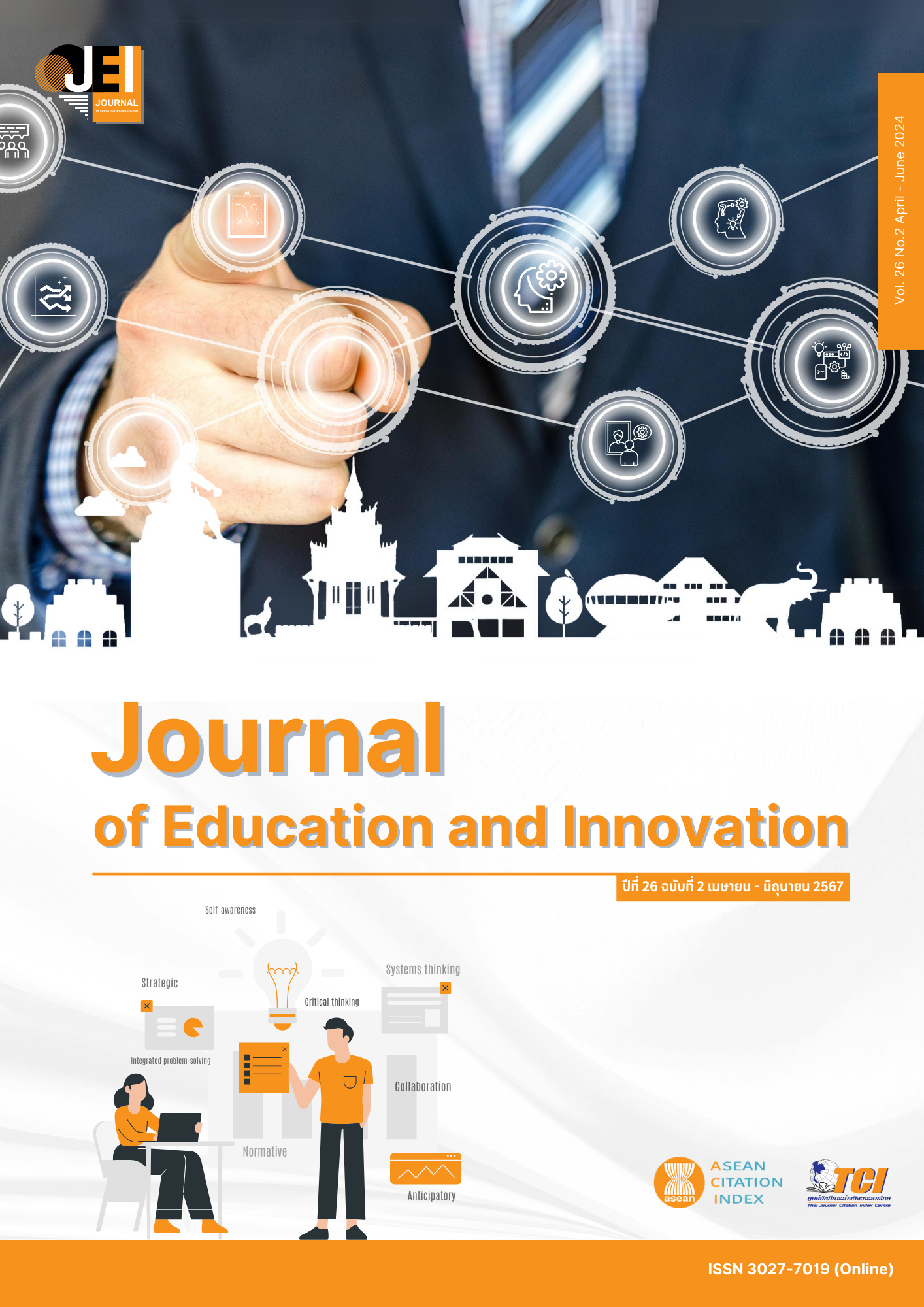การสร้างเสริมทักษะการคิดเชิงประมวลผลและการรับรู้อัตสมรรถนะทางเทคโนโลยี ของนักเรียนชั้นประถมศึกษาปีที่ 4 โดยใช้กิจกรรมการสร้างนิทานชีวลักษณ์บนสแครช ด้วยกลวิธีการเรียนรู้แบบเพื่อนช่วยเพื่อน
Main Article Content
บทคัดย่อ
งานวิจัยนี้มีวัตถุประสงค์เพื่อ 1) พัฒนากิจกรรมการสร้างนิทานชีวลักษณ์บนสแครชด้วยกลวิธีการเรียนรู้แบบเพื่อนช่วยเพื่อนที่มีประสิทธิภาพ 2) ศึกษาผลของการเรียนโดยใช้กิจกรรมนี้ต่อทักษะการคิดเชิงประมวลผลและการรับรู้อัตสมรรถนะทางเทคโนโลยี และ 3) ศึกษาความพึงพอใจของนักเรียนต่อการเรียนด้วยกิจกรรมดังกล่าว กลุ่มตัวอย่างเป็นนักเรียนชั้นประถมศึกษาปีที่ 4 จำนวน 41 คน แบ่งออกเป็น 2 กลุ่มด้วยวิธีการสุ่มกลุ่ม คือ กลุ่มทดลอง ซึ่งเรียนด้วยกิจกรรมการสร้างนิทานชีวลักษณ์บนสแครชด้วยกลวิธีการเรียนรู้แบบเพื่อนช่วยเพื่อน จำนวน 20 คน และกลุ่มเปรียบเทียบ ซึ่งเรียนโดยใช้วิธีการสอนแบบปกติ จำนวน 21 คน นักเรียนทั้ง 2 กลุ่มได้รับการสอบวัดก่อนและหลังเรียน และเรียนเนื้อหาเกี่ยวกับโปรแกรมสแครชเป็นเวลา 8 สัปดาห์ สัปดาห์ละ 2 ชั่งโมง เครื่องมือที่ใช้ในการวิจัย ประกอบด้วย กิจกรรมการสร้างนิทานชีวลักษณ์บนสแครชด้วยกลวิธีการเรียนรู้แบบเพื่อนช่วยเพื่อน แบบทดสอบผลสัมฤทธิ์ทางการเรียนโปรแกรมสแครช แบบวัดทักษะการคิดเชิงประมวลผล แบบสอบถามการรับรู้อัตสมรรถนะทางเทคโนโลยี และแบบสอบถามความพึงพอใจต่อการเรียนด้วยกิจกรรมการสร้างนิทานที่พัฒนาขึ้น สถิติที่ใช้ในการวิเคราะห์ข้อมูล ได้แก่ ค่าเฉลี่ย ส่วนเบี่ยงเบนมาตรฐาน Wilcoxon Match-Pairs Signed Rank Test และ Mann-Whitney U Test ผลการศึกษา พบว่า กิจกรรมการสร้างนิทานชีวลักษณ์ที่สร้างขึ้นมีค่าประสิทธิภาพเท่ากับ 1.46 ซึ่งเป็นไปตามเกณฑ์มาตรฐานของเมกุยแกนส์ มีค่าดัชนีประสิทธิผลเท่ากับ .8148 หลังเรียนนักเรียนในกลุ่มทดลองมีทักษะการคิดเชิงประมวลผล และการรับรู้อัตสมรรถนะทางเทคโนโลยีสูงกว่าก่อนเรียนอย่างมีนัยสำคัญทางสถิติที่ระดับ .01 และ .05 ตามลำดับ และสูงกว่ากลุ่มเปรียบเทียบอย่างมีนัยสำคัญทางสถิติที่ระดับ .01 นอกจากนี้ ยังพบว่า นักเรียนกลุ่มที่เรียนด้วยกิจกรรมการสร้างนิทานชีวลักษณ์บนสแครชมีความพึงพอใจต่อกิจกรรมการเรียนรู้โดยรวมในระดับมาก
Article Details

This work is licensed under a Creative Commons Attribution-NonCommercial-NoDerivatives 4.0 International License.
เจ้าของบทความมิได้คัดลอก หรือละเมิดลิขสิทธิ์ของผู้ใด หากเกิดการละเมิดลิขสิทธิ์ ไม่ว่าวิธีใด หรือการฟ้องร้องไม่ว่ากรณีใด ๆ ที่อาจเกิดขึ้นได้ กองบรรณาธิการวารสารศึกษาศาสตร์ ไม่มีส่วนเกี่ยวข้องทั้งสิ้น ให้เป็นสิทธิ์ของเจ้าของบทความที่จะดำเนินการ
References
Ackerman, C. E. (2020). What is self-efficacy theory in psychology. Retrieved November 15, 2020, from https://positivepsychology.com/self-efficacy/
Ado Oda, A. (2010). The effectiveness of computer-based learning on developing the 4th graders’English language achievement in Gaza UNRWA School (Master thesis). Gaza, Al-Azhar University.
Barr, V., & Guzdial, M. (2015). Advice on teaching CS, and the learnability of programming languages. Communications of the ACM, 58(3), 8-9
Bouchrika, I. (2023). Instructional design models: Gagne’s, Merrill’s and Bloom’s methodologies. Retrieved Marh 1, 2023, from https://research.com/education/instructional-design-models
Brennan, K., & Resnick, M. (2012). Using artefact-based interviews to study the development of computational thinking in interactive media design. Paper presented at annual American Educational Research Association meeting, Vancouver, BC, Canada.
Guraya, S. Y., & Abdalla, M. E. (2020). Determining the effectiveness of peer-assisted learning in medical education: A systematic review and meta-analysis. Journal of Taibah University Medical Science, 15(3), 177-184
Ihmaid, M. K. (2019). The effectiveness of using scratch applications in developing sixth graders’ English vocabulary, it’s retention, and self-efficacy. Retrieved July 2, 2020, from https://Journals.iugaza.edu.ps/index.php /IUGJEPS /article/view/4784
Institute for Promotion of Teaching Science and Technology. (2019). Basic science and technology course, the 4th grade computational science: Teacher guide. Bangkok: Institute for Promotion of Teaching Science and Technology, Ministry of Education.
Isarapreeda, W. (2021). Developing efficient WebQuest–based instruction through online social network for enhancing analytical thinking skill, evaluative thinking, and self-directed learning behavior of teacher education students. Journal of Education and Innovation, 23(4), 330–342.
Jiang, B., & Li, Z. (2021). Effect of scratch on computational thinking skills of Chinese primary school students. Journal of computers in Education, 1-22. DOI:10.1007/ s40692-021-00190-Z
Johnson, R. T., & Johnson, D. W. (2008). Active learning: Cooperation in the classroom. The Annual Report of Educational Psychology in Japan, 47, 29-30
Keller, J. M. (1987). Development and use of the ARCS model of instructional design. Journal of Instructional Development, 10(3), 2-10.
Kotaman, H. (2008). Self-efficacy belief and enhance me of learning performance. Uludog University the Journal of Educational Faculty, 11, 111-133.
Let’s Talk Science. (2018). Computational thinking framework. Retrieved August 2, 2020, from https://letstalkscience.ca/sites/default/files/2019-10/LTS-Computa tional_Thinking-Framework-2018.pdf
Liu, Y. D., & Resnick, M. (2009). Using scratch to enhance students’21st century scientific thinking skills. Retrieved August 10, 2020, from https://ocw.mit.edu/courses/media-arts-and-sciences/mas-714j-technologies-for-creative-Learning fall-2009projects/MIMAS714JF09_ proj4-brief.pdf
Mitsikopoulou, B. (2018). English and digital literacies unit 6.1: Introduction to WebQuests. Athens: National and Kapodistrian, University of Athens, Greece.
Office of the Education Council. (2017). The National Scheme of Education B.E. 2560-2579 (2017-2036). Bangkok: Office of the Education Council. Ministry of Education.
Pathep, N. (2022). Digital Media Development Green Technology for Secondary Schools in Bangkok. Journal of Research and Development Institute of Bansomdejchaopraya Rajabhat University. 5 (1). 23-32.
Phoyen, K. (2021). Active learning: Learning satisfy education in 21th century. Journal of Education Silpakorn University, 19(1), 11-28.
Public Training Project, Fundamental Computer Programming for Education Training Course. (n.d.). Scratch Program training: Introduction to scratch programming. Bangkok: Faculty of Industrial Education, King Monkut’s University of Technology North Bangkok.
Roungrong, P., Kaewurai, R., Namoungon, S, Changkwanyeun, A., & Tengkew, S. (2018). Computational thinking and Thai education. Panyapiwat Journal, 10(3), 322-330.
Sangsiri, M. (2019). Getting to Know SCRATCH: Skill Development Program. Retrieved October 20, 2019, from https://www.scimath.org/article-technology/item-seratch-21
Sikkhabandit, S. (1985). Educational technology. Bangkok: King Monkut’s Institute of Technology North Bangkok.
Supaluk, S. (2018). A cloud based learning system using reverse engineering approach and peer assisted learning (Doctoral dissertation). Bangkok: Chulalongkorn University.
Tennyson, M.F., Casteele, J., & Morena, A. R. P. (2018). A study of peer-assisted learning in introductory programming courses. Journal of Computing Sciences in Colleges, 33(5), 1-2.
Wing, J. M. (2011). Research notebook: Computational thinking-what and why? Retrieved October 20, 2022, from https://www.cs.cmu.edu/link/research-notebook-computational-thinking-what-and-why
Yukselturk, E., & Altiok, S. (2016). An investigation of effects of programming with scratch on the pre-service it teachers’ self-efficacy perceptions and attitudes towards computer programming. British, Journal of Educational Technology, 48(3), 789-801.

